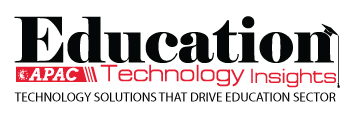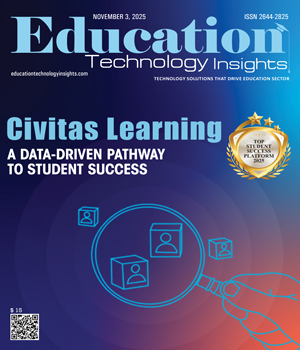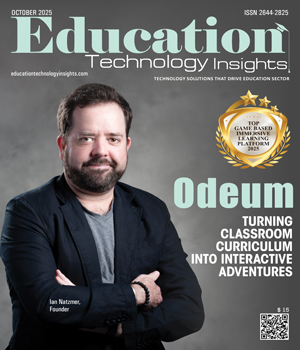THANK YOU FOR SUBSCRIBING
Be first to read the latest tech news, Industry Leader's Insights, and CIO interviews of medium and large enterprises exclusively from Education Technology Insights
How advancing digital learning resources can drive student engagement in higher education
Adrian Gallagher, Associate University Librarian,Learning Resources, Technology and Infrastructure, Victoria University
 Adrian Gallagher, Associate University Librarian,Learning Resources, Technology and Infrastructure, Victoria University
Adrian Gallagher, Associate University Librarian,Learning Resources, Technology and Infrastructure, Victoria UniversityA crucial part of any student’s experience is engaging with the learning resources essential for supporting their development and progress within a course (eg .course guides, e-texts, library information resources, course video resources). Prior to COVID 19 there was already a significant shift in the adoption of digital course resources in higher education particularity through the central role of learning management systems (Virtual Learning Environments) acting as digital gateways for learning objects, digital reading lists and video streaming content. At my host institution, Victoria University, our D2L Brightspace Learning Management system was strengthened by integrations with H5P, eReserve Plus for digital readings and the Panopto video streaming service.
Extending the take-up of digital learning resources at Victoria University was further assisted by the implementation of a new Block Model for course delivery which re-structured course units from the traditional semester length model to holding all undergraduate units in four week blocks. To achieve this radical change, a complete re-design of course content was required which resulted in a systematic approach to applying the university digital infrastructure across all units and ensuring higher standards were applied to the treatment of digital learning resources. Integrated design teams were employed to develop these course units and help align the new pedagogy with the application of these digital learning resources.
When COVID19 made its unexpected arrival, the Victoria University digital infrastructure supporting course learning resources was already in place and therefore able to upscale to take the load required with from the sudden shift to full online delivery. This experience was in contrast to the shock faced by campus based delivery in the classroom which had generally only used cloud-based video conferencing and session platforms in a supplementary way. COVID 19 required the sudden application of these digital tools to all class course delivery with the rapid transition to real time online tutorials, lectures, online assessment and other online networking and collaboration tools. Therefore the class online experience was marked by rapid staff and student training and adoption. For digital resources on the other hand, the transition was smoother and the main additions where the digitization of the help desk services offering help to students in facilitating access to resources.
“Student engagement with the digital tools will enhance their research skills development and digital literacy within an environment of independent learning”
The digital infrastructure for course learning resources had also been advanced through the merger and interaction of different branches of education technologies from Student Management Systems, Learning Management Systems (LMS) and library platforms through the benefit of API integrations, and unified authentication. For example the digital reading list LTI (Learning Tools Interoperability) integrations for essential course resources within LMS units successfully applied single sign-on, link resolution and copyright management to allow a seamless experience for the user. As engaging with course readings is essential for academic success, it is useful for the tools to deliver analytics providing evidence and tracking of participation. These analytics can be delivered on a real time basis to academics allowing in class assessment of participation and consequential interventions to assist retention and progress. Further engagement can occur through an interactive approach to course resources through the layering of activities/assessment over digital material through from video streaming services and other content collaboration tools including the creation, sharing and reusing of interactive HTML5 content.
In addition to delivering resources through the Learning Management system, services must be provided to assist student engagement with the wealth of learning resources within publisher collections and the developing Open Access community resources on the web. This process of Discovery can be facilitated by both Library based Discovery services (library search engines/catalogues) and tools extending institutional access to browser based search engines (eg browser extensions for Google). Library Discovery remains essential for providing a consolidated and central access point to navigate the mass of material on different publisher platforms or open access sources. Libraries can also assist students in using Google for this purpose with authentication aids or browser extensions for linking up to institutional subscriptions. Further student engagement with these tools will enhance their research skills development and digital literacy within an environment of independent learning.
The increased emphasis on the digital delivery of learning resources we have seen under COVID is likely to continue into the future when mixed modes of delivery replace the offsite restrictions demanded by the peak of the pandemic. Both students and staff of higher education institutions have tasted the alternatives to campus based study and will continue to seek flexible options for competing their courses. This change will require educational institutions to address some of the key remaining challenges within current online models; particularly the restricted availability of high value publisher content and limitations of proprietor content or cross vendor incompatibility. Some high value digital content (eg selected e-texts) cannot be access by educational organizations within a sustainable financial model where finances have been stressed under COVID 19 as a result of disruptions in the flow of international students. One option for exploring new digital content comes from the expansion and sharing of Open Education Resources (OERs) as an affordable means for tailored discipline content without unreasonable costs for the student or institution. To achieve this, more development of digital infrastructure is required for open platforms, resource discovery and the sharing of open content. Progress in this area would further advance student engagement and maximize the engagement with learning resources essential for a student’s success.
Read Also
Empowering Educators through Purposeful, Connected and Transformative Learning
Empowering Students to Lead: A New Vision for Civic Learning
The Director's Playbook: Strategic Digital Transformation in Rual Hyper-Growth Districts
The Art and Architecture of Student Support
From At-Risk to At-Promise: The Language Revolution Higher Education Needs
Teaching Tomorrow: How Western Governors University Is Redefining Teacher Preparation

I agree We use cookies on this website to enhance your user experience. By clicking any link on this page you are giving your consent for us to set cookies. More info






















